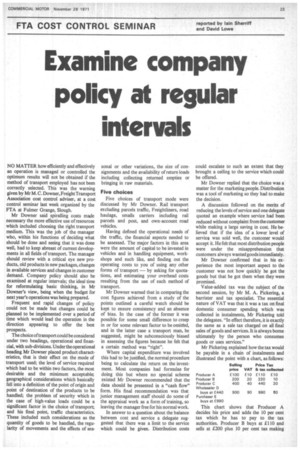Examine company poky at regular intervals
Page 23

If you've noticed an error in this article please click here to report it so we can fix it.
NO MATTER how efficiently and effectively an operation is managed or controlled the optimum results will not be obtained if the method of transport employed has not been correctly selected. This was the warning given by Mr M. C. Downer,Freight Transport Association cost control adviser, at a cost control seminar last week organized by the FTA at Fulmer Grange, Slough.
Mr Downer said spiralling costs made necessary the more effective use of resources which included choosing the right transport medium. This was the job of the manager who, within his functions of deciding what should be done and seeing that it was done well, had to keep abreast of current developments in all fields of transport. The manager should review with a critical eye new products, old products in new packages, changes in available services and changes in customer demand. Company policy should also be examined at regular intervals; the ideal time for reformulating basic thinking, in Mr Downer's view, being when the budget for next year's operations was being prepared.
Frequent and rapid changes of policy could not be made but changes could be planned to be implemented over a period of time which would lead the operation in the direction appearing to offer the best prospects.
The choice of transport could be considered under two headings, operational and financial, with sub-divisions. Under the operational heading Mr Downer placed product characteristics, that is their effect on the mode of transport used; the level of service required which had to be within two factors, the most desirable and the minimum acceptable; geographical considerations which basically fell into a definition of the point of origin and point of destination of the products to be handled; the problem of security which in the case of high-value loads could be a significant factor in the choice of transport; and his final point, traffic characteristics. These included such considerations as the quantity of goods to be handled, the regularity of movements and the effects of sea
sonal or other variations, the size of consignments and the availability of return loads including collecting returned empties or bringing in raw materials.
Five choices
Five choices of transport mode were discussed by Mr Downer. Rail transport excluding parcels traffic, Freightliners, road haulage, smalls carriers including rail parcels and post, and own-account road vehicles.
Having defined the operational needs of the traffic, the financial aspects needed to be assessed. The major factors in this area were the amount of capital to be invested in vehicles and in handling equipment, workshops and such like, and finding out the operating costs to you of using any other forms of transport — by asking for quotations, and estimating your overhead costs resulting from the use of each method of transport.
Mr Downer warned that in comparing the cost figures achieved from a study of the points outlined a careful watch should be kept to ensure consistency and an absence of bias. In the case of the former it was possible for some small difference to creep in or for some relevant factor to be omitted, and in the latter case a transport man, he suggested, might be subconsciously biased in assessing the figures because he felt that a certain method was "right".
Where capital expenditure was involved this had to be justified, the normal procedure being to calculate the return on the investment. Most companies had formulae for doing this but where no special scheme existed Mr Downer recommended that the data should be presented in a "cash flow" form. His final recommendation was that junior management staff should do some of the appraisal work as a form of training, so leaving the manager free for his normal work.
In answer to a question about the balance between cost and service a delegate suggested that there was a limit to the service which could be given. Distribution costs
could escalate to such an extent that they brought a ceiling to the service which could be offered.
Mr Downer replied that the choice was a matter for the marketing people. Distribution was a tool of marketing so they had to make the decision.
A discussion followed on the merits of reducing the levels of service and one delegate quoted an example where service had been reduced without complaint from the customer while making a large saving in cost. He believed that if the idea of a lower level of servica was sold well, the customer would accept it. He felt that most distribution people were under the misapprehension that customers always wanted goods immediately.
Mr Downer confirmed that in his experience the most important aspect to the customer was not how quickly he got the goods but that he got them when they were promised.
Value-added tax was the subject of the second session, by Mr M. A. Pickering, a barrister and tax specialist. The essential nature of VAT was that it was a tax on final domestic consumer spending which was collected in instalments, Mr Pickering told the delegates. "In effect therefore, it is exactly the same as a sale tax charged on all final sales of goods and services. It is always borne ultimately by the person who consumes goods or uses services."
Mr Pickering explained how the tax would be payable in a chain of instalments and illustrated the point with a chart, as follows: This chart shows that Producer A decides his price and adds the 10 per cent tax which he has to pay to the tax authorities. Producer B buys at £110 and sells at £200 plus 10 per cent tax making


















































































